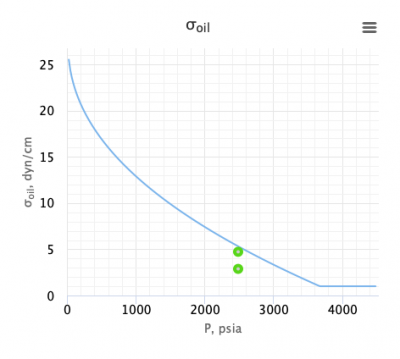Difference between revisions of "Gas/Oil Interfacial Tension"
From wiki.pengtools.com
(→Gas/Oil Interfacial Tension) |
|||
| Line 4: | Line 4: | ||
[[Gas/Oil Interfacial Tension]] correlation was published by '''Baker and Swerdloff''' in '''1956'''. | [[Gas/Oil Interfacial Tension]] correlation was published by '''Baker and Swerdloff''' in '''1956'''. | ||
| − | [[File:Gas | + | [[File:Gas-Oil Interfacial Tension.png|thumb|right|400px|Gas/Oil Interfacial Tension correlation in the PVT software at pengtools.com]] |
==Math and Physics== | ==Math and Physics== | ||
Revision as of 08:30, 5 October 2020
Gas/Oil Interfacial Tension
Gas/Oil Interfacial Tension correlation was published by Baker and Swerdloff in 1956.
Math and Physics
The interfacial tension becomes zero at miscibility pressure. 1 dyne/cm is used for calculations, then it becomes less than 1.
Nomenclature
 = pressure, psia
= pressure, psia = oil specific gravity, °API
= oil specific gravity, °API = gas/oil interfacial tension, dynes/cm
= gas/oil interfacial tension, dynes/cm = gas/oil interfacial tension for dead oil, dynes/cm
= gas/oil interfacial tension for dead oil, dynes/cm = temperature, °F
= temperature, °F
See also
Gas/Oil Interfacial Tension
Gas/Water Interfacial Tension
References
Baker, O. and Swerdloff, W. 1955. Calculation of Surface Tension 3—Calculating parachor Values. Oil Gas J. (5 December 1955): 141.
Baker, O. and Swerdloff, W. 1956. Calculation of Surface Tension 6—Finding Surface Tension of Hydrocarbon Liquids. Oil Gas J. (2 January 1956): 125.








